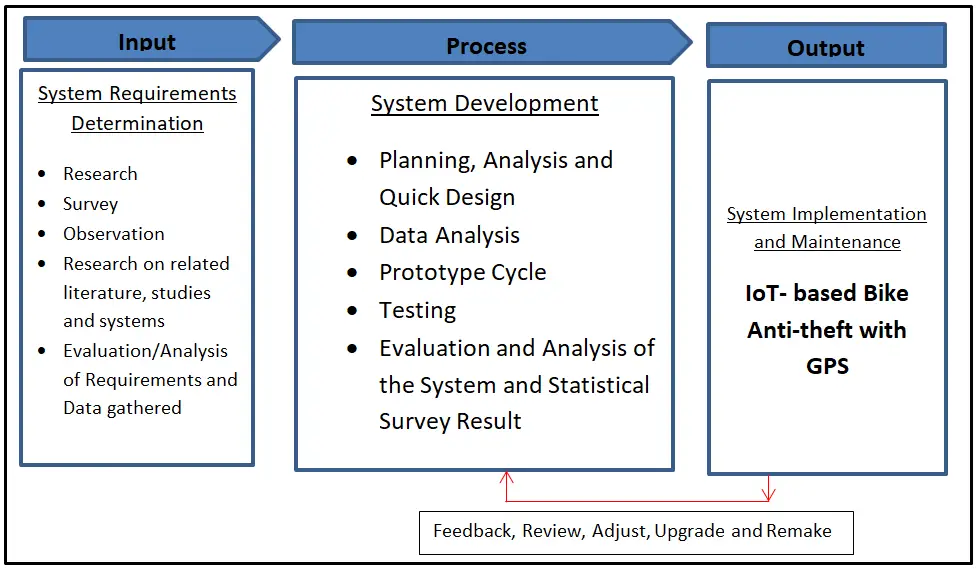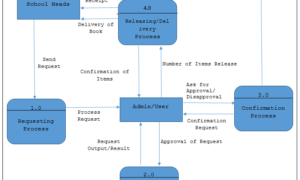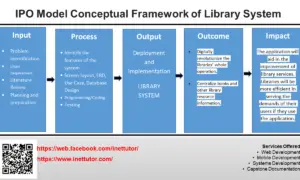Conceptual Framework of IoT-based Bike Anti-Theft with GPS
This post will demonstrate how to develop a conceptual framework for a capstone project entitled IoT-based Bike Anti-Theft with GPS. The study’s conceptual framework was built using the input, process, and output (IPO) model.
About the Project
Table of Contents
In an era where technology is rapidly evolving, the Internet of Things (IoT) is transforming various aspects of our lives. One such area where IoT is making a significant impact is in the realm of bike security. The integration of IoT with bikes has led to the development of innovative solutions, such as IoT-based bike anti-theft systems with GPS tracking. These systems provide an effective means of safeguarding your two-wheeled companion while offering the convenience of real-time tracking. Bike theft is a pervasive issue worldwide. According to statistics, millions of bicycles are stolen every year, leaving their owners frustrated and financially burdened. Traditional locks and alarms, while helpful to some extent, are not safe, as determined thieves have found ways to bypass them. This is where IoT-based bike anti-theft systems come into play, offering a more sophisticated and reliable solution.
Objectives of the Study
- Enhance Bike Theft Prevention: Develop an advanced bike security system that not only deters potential thieves but also actively prevents theft by employing state-of-the-art security measures, such as biometric authentication and tamper-resistant locks.
- Real-time GPS Tracking and Location Monitoring: Implement a robust real-time GPS tracking feature that enables bike owners to continuously monitor the precise location of their bikes around the clock. This feature will not only provide peace of mind to owners but also facilitate rapid recovery in case of theft.
- Remote Security System Management: Create a user-friendly mobile application or web interface that allows bike owners to remotely manage and monitor the security system of their bikes. This includes arming/disarming security features, adjusting sensitivity settings, and reviewing security logs.
- Instant Alerts and Notifications: Integrate a smart notification system that promptly informs bike owners of any suspicious activity, unauthorized access attempts, or unexpected movements of their bikes. These real-time alerts will empower owners to take immediate action to protect their valuable assets.
What is a Conceptual Framework?
A conceptual framework serves as the foundational structure and guiding principles for a project, research study, or system development. In the context of the IoT-based Bike Anti-Theft with GPS, a conceptual framework has several important roles and benefits:
- Defining Objectives and Scope: The conceptual framework helps in clearly defining the objectives of the project. It outlines what the IoT-based Bike Anti-Theft system aims to achieve, such as preventing theft, enhancing security, and providing GPS tracking. It also helps in delineating the scope of the project, specifying what features and functionalities will be included.
- Structured Approach: It provides a structured approach to system development. By breaking down the project into components like data collection (sensors), data processing (anti-theft algorithms), and data utilization (GPS tracking), the conceptual framework ensures that every aspect is well-defined and organized.
- Guidance for Research and Design: A conceptual framework guides research efforts by identifying the key components and variables relevant to the project. It helps in determining what technology, sensors, and communication protocols should be considered. It also directs the design process, ensuring that the system aligns with the defined objectives.
- Alignment with User Needs: It ensures alignment with user needs and expectations. By considering factors like user convenience, ease of use, and the need for real-time tracking, the framework helps in designing a system that caters to the practical needs of bike owners.
- Risk Mitigation: The framework aids in identifying potential challenges and risks early in the development process. For instance, it may highlight issues related to data security, system reliability, or power consumption, allowing developers to address these concerns proactively.
- Scalability and Flexibility: It allows for scalability and flexibility. The framework can account for future enhancements or modifications to the system, such as adding support for multiple bikes or integrating with mobile apps.
- Project Management: It assists in project management by providing a clear roadmap for development. Project timelines, milestones, and resource allocation can be determined based on the framework.
Conceptual Framework Diagram

The image above depicts the project’s conceptual framework, entitled IoT-based Bike Anti-Theft with GPS. It is based on the input, process, and output (IPO) model.
Input
In the Input Phase of developing an IoT-based Bike Anti-Theft System with GPS, several critical activities pave the way for project success. Market research guides understanding of market demand, while user requirements analysis captures the expectations of potential users. Technology assessment identifies suitable IoT components, risk assessment anticipates and mitigates challenges, and conceptualization outlines key system features. Detailed hardware and software specifications specify components and platforms, data security planning addresses information protection, and budgeting ensures resource allocation. A well-defined project timeline aids in monitoring progress, ethical considerations ensure responsible data usage, and feasibility studies assess project viability. Prototyping validates hardware and software choices, confirming their feasibility. Altogether, these activities create a solid foundation, aligning the project with user needs and ethical standards while identifying potential hurdles for preemptive resolution.
Process
The researchers will select and choose the optimum software development life cycle model for the project in this section.
Planning, Analysis and Quick Design
During Analysis and Quick Design, the researchers did a personal interview with the respondents and the chosen client where the study was conducted. The respondents were given the chance to suggest how the system will be designed. After conducting the data gathering, the researchers made an initial design for the proposed system.
Data analysis
Consultation is used to gather requirements from end users and generate ideas. We also distributed a survey questionnaire that was authorized by three experts (IT Expert, English Grammarian, and Researcher). And these questionnaires functioned as our data gathering tool, measuring the performance of the manual system that served as the foundation for the development of our proposed system.
Prototype Cycle
This stage will consist of the researchers’ data being compiled, built, demonstrated, and refined. The researchers create a prototype first, based on the planned design and data tables. The prototype will be shown to the client after it has been built. The researchers demonstrate the system’s operation, the flow of how it operates, and the functions of the system’s features. The next stage is refining, in which the researchers will fine-tune the system based on the client’s extra requirements. Changes to the features flow and functionalities will be made based on the needs.
Testing and Evaluation
This will include the feed backing of the proposed system after it will be implemented and had undergone testing by three Experts. It will also inform the researchers and the developer if there are any bugs, suggestion and if the system’s functionality will works well.
This will discuss the implementation of the proposed system wherein Three (3) Experts will evaluate the proposed system. This will also discuss if the recommended functions and suggestion are met.

Output
The project comes to life and is executed in the real world after all of the necessary procedures have been completed. A new project is born, and it will be maintained for the project’s long-term survival.
The Output Phase in the development of an IoT-based Bike Anti-Theft system with GPS marks the practical realization of the project’s objectives. It begins with the hands-on implementation of the system, where the hardware and software components are meticulously assembled. Sensors, GPS modules, and anti-theft algorithms are integrated to form a cohesive system designed to deter theft and provide real-time tracking. Once assembled, the system is installed on bicycles in a live environment, with sensors strategically placed and GPS units securely fixed. Rigorous testing and calibration follow to ensure accuracy and reliability. User training is a crucial aspect, ensuring bike owners understand how to utilize the system effectively. Continuous monitoring is key as the system tracks bike movements and communicates with a central server, sending alerts for unauthorized access. Regular updates and upgrades keep the system robust and responsive to evolving needs. Ultimately, this phase transforms the theoretical concept into a practical, user-friendly tool that empowers bike owners to protect their assets and enjoy the benefits of real-time tracking and enhanced security.
Summary
The blog post delves into the intriguing world of IoT-based Bike Anti-Theft systems with GPS, exploring how the IPO (Input-Process-Output) model serves as the guiding light for this innovative technology. It commences by dissecting the Input Phase, detailing how market research, user requirements analysis, and technology assessment set the stage for this groundbreaking project. The subsequent Process Phase comes to life, showcasing the development and implementation of anti-theft measures, real-time GPS tracking, and user-friendly interfaces. Lastly, the Output Phase is unveiled, emphasizing the practical deployment, testing, and continuous improvement of the system in real-world environments. Throughout this journey, the blog post paints a vivid picture of how the IPO model conceptual framework shapes the development and success of IoT-based Bike Anti-Theft with GPS, promising enhanced security and peace of mind for bike owners.
Readers are also interested in:
IOT Garbage Monitoring System using Arduino with Bluetooth Application
Receive Bluetooth Data from Arduino to MIT App Inventor (HC-05/06)
You may visit our Facebook page for more information, inquiries, and comments. Please subscribe also to our YouTube Channel to receive free capstone projects resources and computer programming tutorials.
Hire our team to do the project.


